
|

|
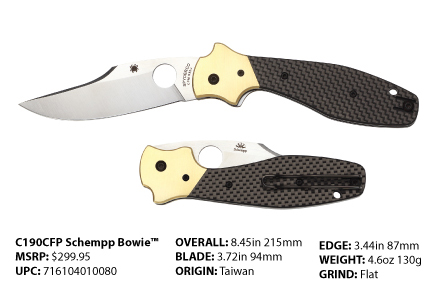
Designed by renowned custom knifemaker and bladesmith Ed Schempp, the Schempp Bowie™ brings Spyderco’s popular Ethnic Series of knives home by honoring the classic American Bowie Knife.
Named after the legendary frontiersman and folk hero James Bowie, “Bowie Knife” is a generic term that is used to collectively describe a broad range of fixed-blade knives that were popular during the early 19th century. Although the exact design of Bowie’s personal knife remains a mystery and many different styles of Bowie Knife have been documented, in its most iconic form, it features a broad blade with an upswept tip and a clip point. This style of Bowie was also immortalized by Alan Ladd’s portrayal of Bowie in the classic movie Iron Mistress and was therefore a fitting inspiration for Spyderco’s Schempp Bowie.
The heart of the Schempp Bowie is its distinctive blade, which faithfully retains the broad profile, long belly, and concave clip point of the classic Bowie pattern. Precision machined from premium CPM® S30V® powdered metallurgy stainless steel, it combines a high flat grind with a reinforced, full-thickness spine to combine strength and low-friction edge geometry. A Trademark Round Hole™ unmistakably brands it as a Spyderco design and ensures swift one-handed opening with either hand.
The Schempp Bowie’s extraordinary handle is not only a unique blend of tradition and state-of-the-art materials; its highly refined design also maximizes the functionality of the knife as both a utility and personal-defense tool. The handle is constructed with skeletonized full stainless steel liners, textured carbon fiber/G-10 laminate scales, a solid steel backspacer, and classic brass bolsters. The bolsters include a subtle but extremely functional integral double guard and they are fitted to the scales with a meticulously machined dovetail joint—a touch of class normally reserved for custom knives. In classic Bowie tradition, the handle has a “coffin-shaped” profile, but its angle to the blade is slightly dropped. This subtle detail is found on many of Schempp’s designs and allows the blade to instinctively align with the axis of the forearm while maintaining a straight, natural wrist angle. This alignment increases cutting power and depth and reduces fatigue during prolonged use. In a folder, it also shortens the opening arc of the blade and enhances the knife’s deployment speed.
From a personal-defense standpoint, the handle design of the Schempp Bowie allows the knife to instinctively come to a classic Bowie-style guard position when properly gripped. In a saber grip—with the thumb braced against the top portion of the guard—the blade instinctively points right at the opponent’s eyes. When aligned in this way, the opponent loses depth perception and is vulnerable to quick linear thrusts.
The Schempp Bowie can also be gripped like a traditional Indonesian Kris—bracing the handle against the palm (like a pistol) and extending the index finger along the blade. In this grip, the blade “rides” the action of the index finger and is capable of powerful, extremely accurate thrusts.
To lock the blade securely in the open position, the Schempp Bowie features a stout LinerLock mechanism. Although easily operated, the lock release is designed to be nearly flush with the contour of the bolsters to preserve the classic lines of the knife and help prevent unintentional activation during use. A reversible deep-pocket wire clip completes the package, offering discreet tip-up carry and ensuring that the knife is instantly accessible when needed.
Ed Schempp has hit yet another home run with the Schempp Bowie, paying homage to a classic American cultural symbol while creating a knife that successfully blends traditional style and state-of-the-art manufacturing and materials. We sincerely hope you’re as excited about the Schempp Bowie as we are.
|

|

|
MEET KNIFEMAKER ED SCHEMPP
Ed Schempp calls Ephrata, Washington home. Here, he’s a third-generation wheat farmer. When he’s not growing wheat, he’s a first-generation knifemaker. Ed was kind enough to sit down with Spyderco and share his personal knifemaking background and talk about where he’s headed in the future. Mr. Schempp will be attending the 2015 Blade Show in Atlanta, Georgia this June if you would like to meet him.
Ed, can you explain to our readers what got you started knifemaking?
I've loved knives all my life. After kindergarten I would go to my grandpa’s to be babysat until my mother’s teaching job was done for the day. My grandpa had a hand crank grinder and a piece of scrap steel that I made into a knife, more like a shank. A blacksmith who worked on the farm at the time taught me about forging and heat treating. I started making "farmer throwing stars" from used sickle blades when I was 10. Then I moved onto making high speed hacksaw blades into knife blades. By age 12, I had made many knives by myself and moved on as a production knife collector. In 1991, I bought a heat-treated blank from knifemaker Bob Egnath and have not looked back or stopped making knives since.
You are the primary designer of the Spyderco Ethnic Series. How do you approach the unique/unusual design features and cultural back stories when deciding how to make an original ethnic knife into your modern folding representation? Take the Schempp Bowie for an example.
I try and keep as many iconic traits of a cultural piece that I can, and adapt those to a folder. Many original Bowie knives were imported from Sheffield, England and Solingen, Germany. American Bowie makers stylized and added ergonomic improvements to those traditional Bowies. Adaption is a historical trait and I try and continue that process to my folders.
Do you have favorite materials (blade and handle) that you gravitate toward for your custom pieces?
I prefer pattern welded and laminate steel to homogenous material. Handle material is chosen to fit the needs of the piece. I use a fair amount of linen Micarta. I like stag, bone, ivory, and exotic woods, generally material that will not float.
What’s on the horizon for future projects with you both as a custom maker and as a collaborator with Spyderco?
I like the challenge of a "new" adaptation or design trying to make the piece ergonomic and make the evolved design work better than what is currently offered. This year I took on folding kitchen knives, daggers, and horticultural hawkbills. I like a challenge to keep me focused.
Mr. Schempp can be reached via email:
eschempp
-- at --
televar.com
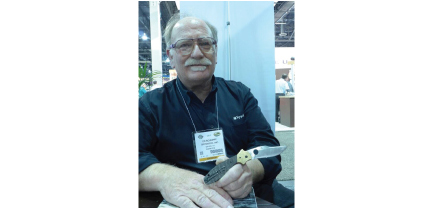
|

|

|
SPYDERCO BUILDING EXPANSION IN FULL SWING GOLDEN, COLORADO
Spyderco’s roots run deep in Golden, Colorado. The company opened its doors here in 1980 after running a mobile sharpening business out of a bread truck during the 1970s. The town of Golden has a long and colorful history as an 1880s mining town that had (and still has) a tapestry of characters who call it home including: miners/prospectors, artists, engineering scholars, immigrants, merchants and business founders; some with a taste for beer and some with a proclivity toward knives.
For 150 years Golden has welcomed businesses and hardworking entrepreneurs by fostering a remarkable record of success, notable even by small town standards, with impressive longevity in its commercial climate. Spyderco’s original wholesale and retail offices were located on Old Golden Road in what was formerly the Old Golden Post Office built pre-1940. As the company expanded it meant moving part of business to a larger location in early 1994 on the north side of town off Highway 93 and Pine Ridge Road. Here the corporate offices tended the business end while Spyderco’s manufacturing facility was opened across town in a south Golden business park. By 1997 the ideal location to house both sides of the business became available and was purchased. The new digs were large enough to have both the corporate and manufacturing halves of the company under the same roof. Today in 2015, with continuing growth, we have found it necessary to construct an addition to our current facility. Ground was broken on a 17,000 square feet manufacturing-area addition in 2014. Once the crew, new machinery, and material storage are settled in later this year, Spyderco will celebrate with an official ribbon cutting ceremony.
As a company and an active participant in the community, Spyderco is grateful and honored to have our business rooted in Golden. Although we began our business in a bread truck and moved around town, vagabond-style, to different office and manufacturing locations, we are as strongly committed today as we were in the 1980s to making reliable high-performance knives and doing so in our hometown of Golden, Colorado.
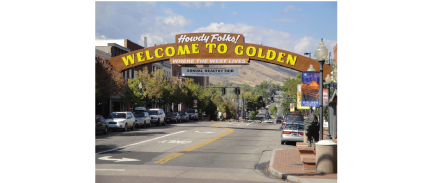
Golden’s Downtown Area Photo Credit: postofficeworld.com
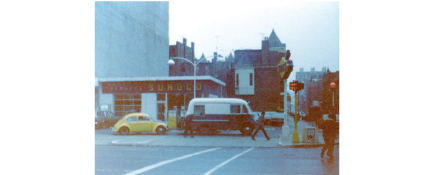
Spyderco Bread Truck which housed the newly founded Spyderco business from 1976-1979
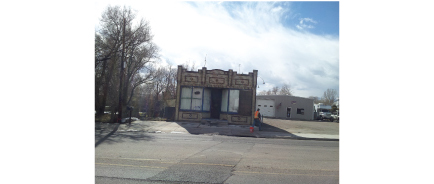
Spyderco retail outlet 1982
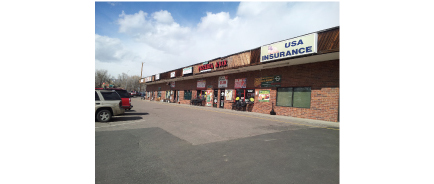
Strip mall where Spyderco’s wholesale office was located from 1980-1994
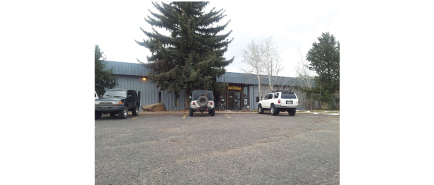
Spyderco corporate headquarters 1994-1997
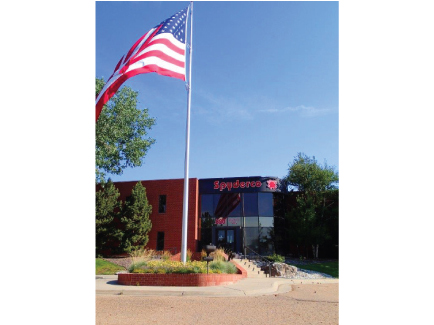
Spyderco’s corporate office & manufacturing facility from 1997-today

New Spyderco expansion to our facility: Summer 2014
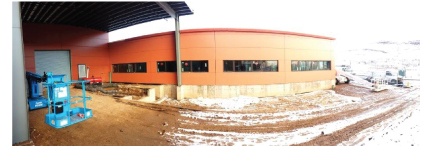
New Spyderco expansion to our facility: Winter 2015
|

|

|
C158TIP TECHNO FOLDER FEATURES A TEMPORARY BLADE STEEL CHANGE
Have you always wanted a postage stamp printed upside down? Here’s your opportunity.
The C158TIP Techno is Spyderco / Marcin Slysz collaboration. When released, the blade steel for the model was Carpenter Steel’s CTS® XHP.
“Pobody’s Nerfect” - we goofed!
A single production run released this month has a Crucible CPM® S30V blade steel. Carpenter CTS XHP and Crucible CPM S30V are both steels produced here in the United States with the highest rating for cutting performance, edge retention and rust resistance. Once the run of “Oops Technos” are gone the model will return this autumn back to its original CTS XHP blade steel. The CPM S30V Techno is shipping now with no change in pricing from the CTS XHP version. MSRP: $319.95
|
|









